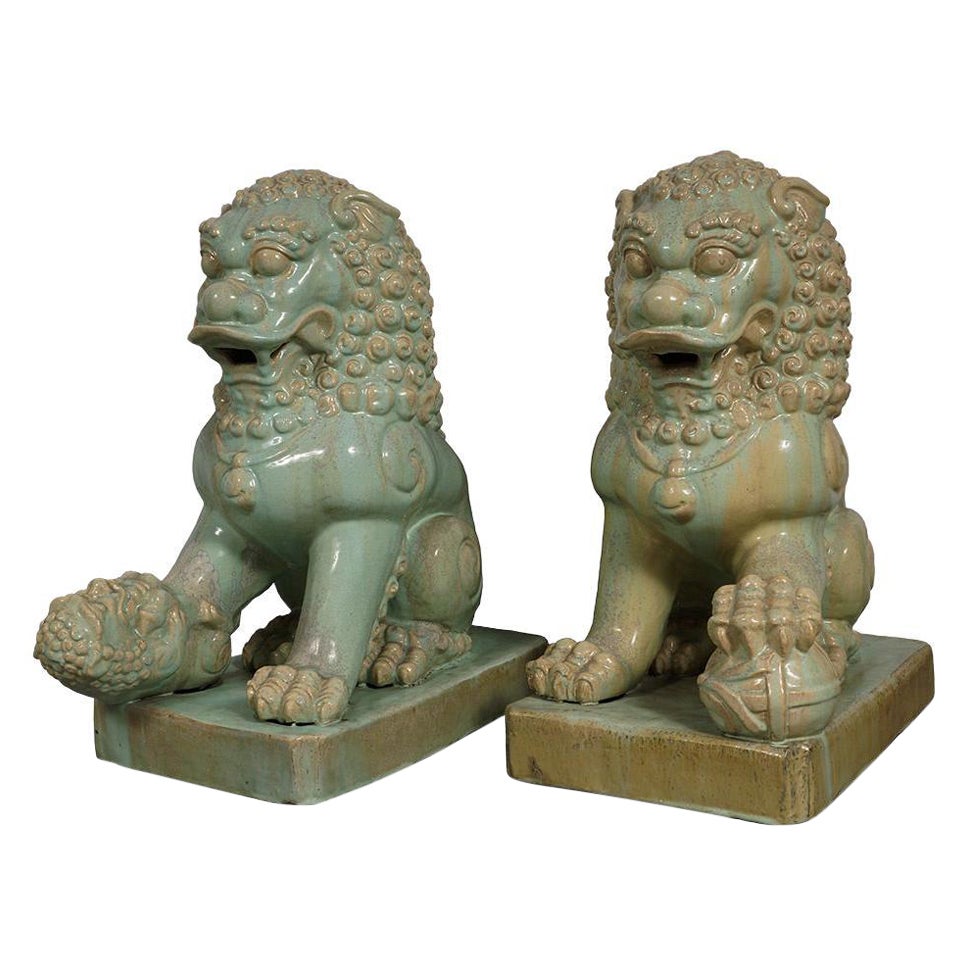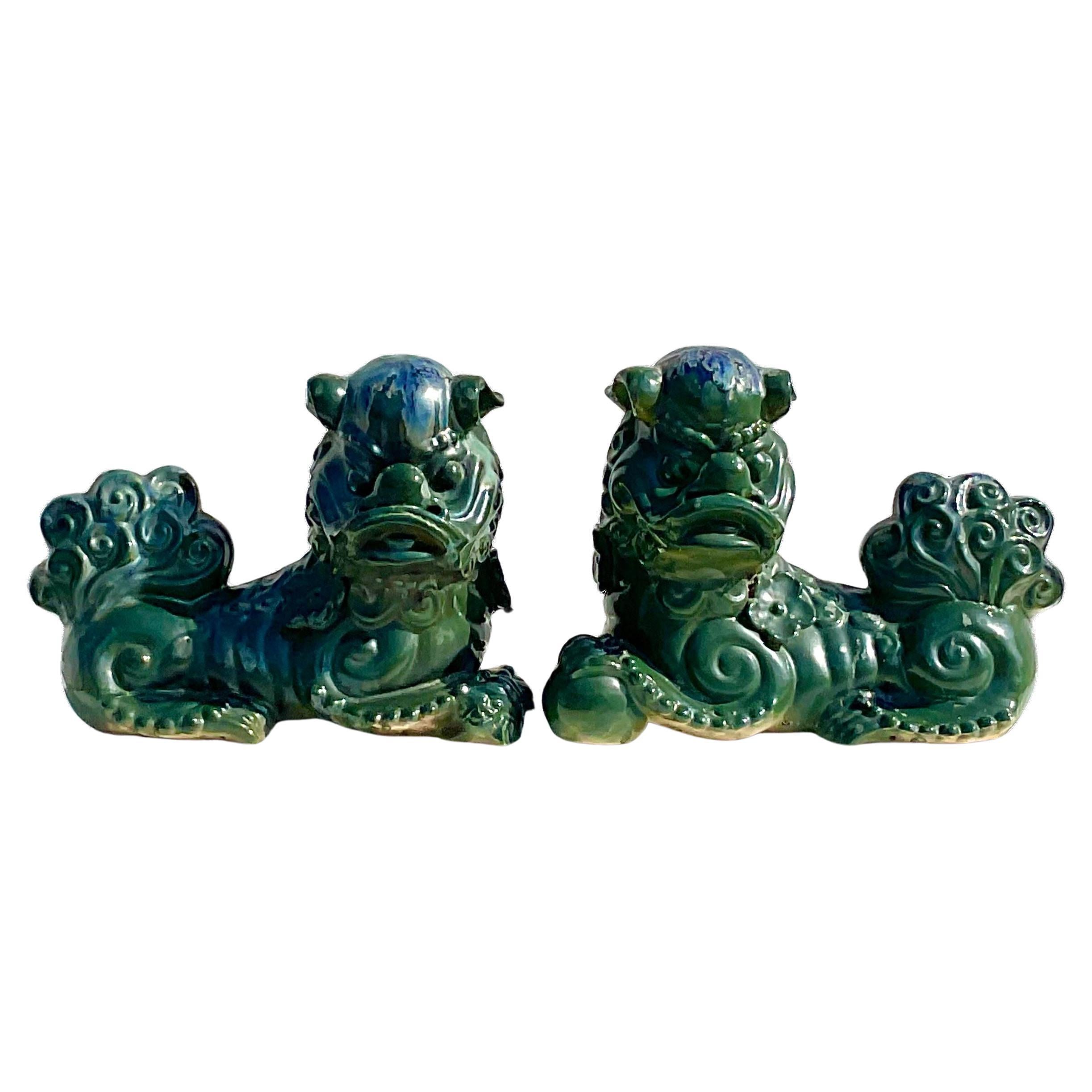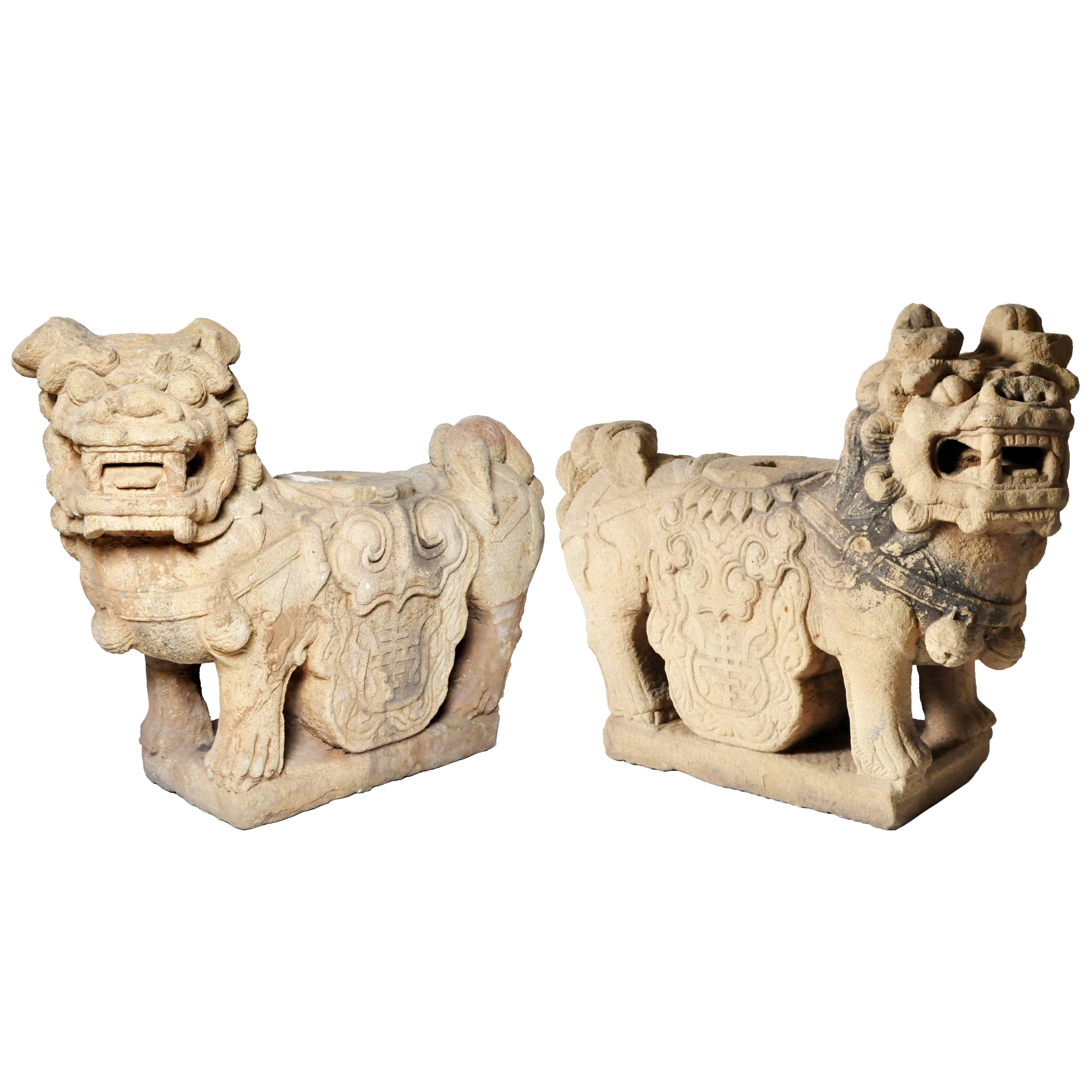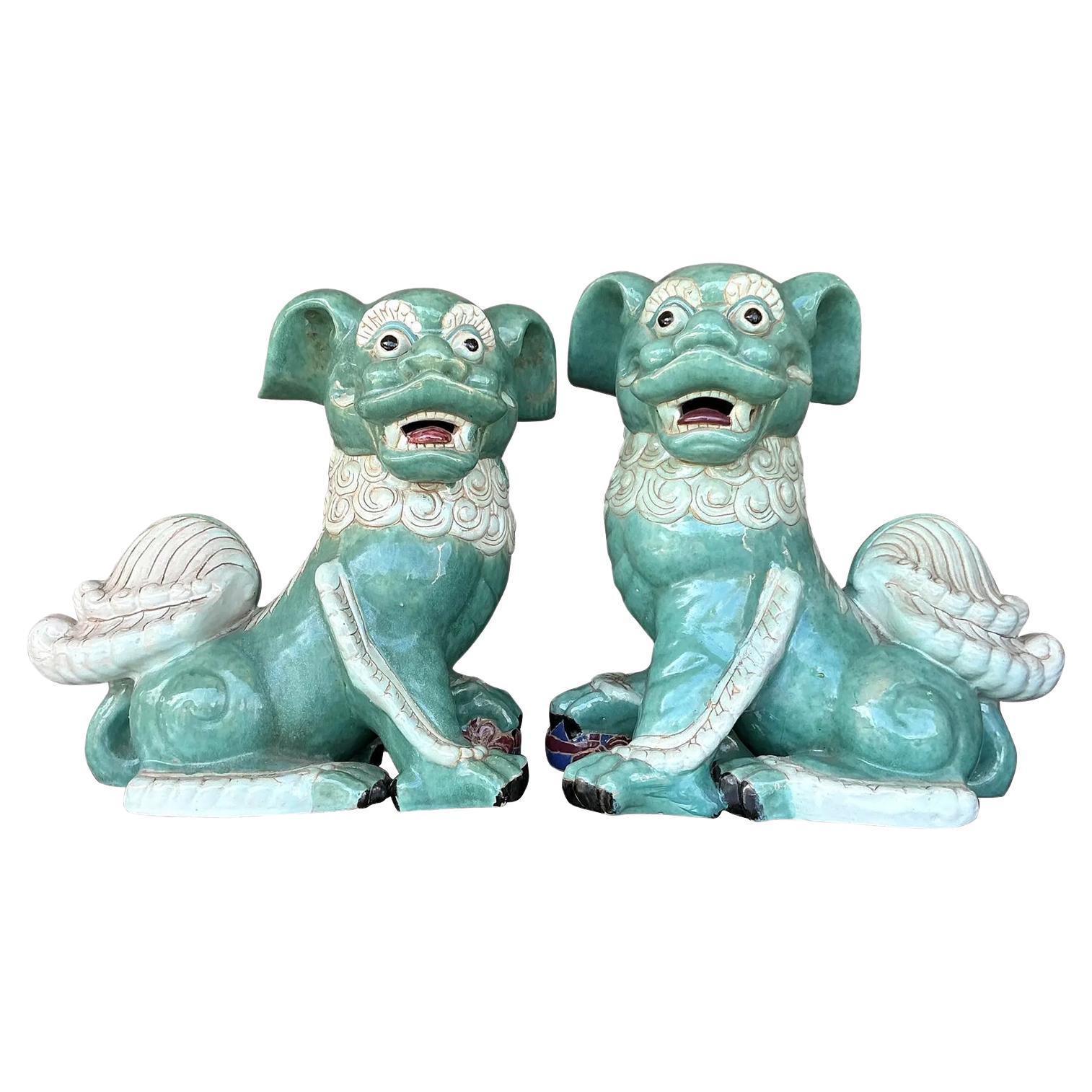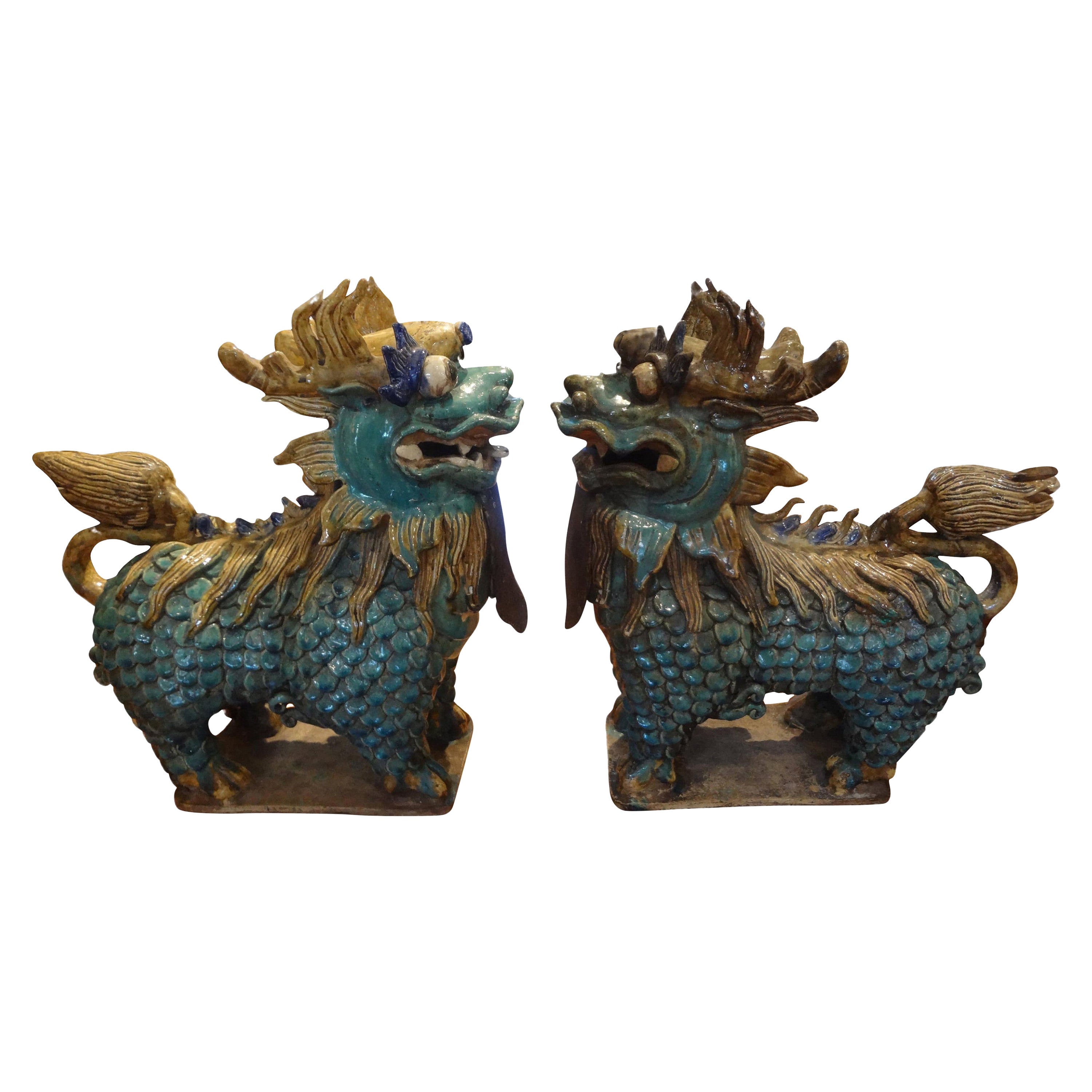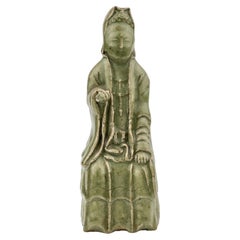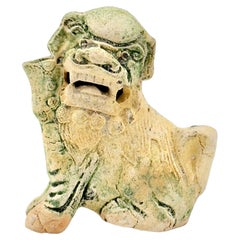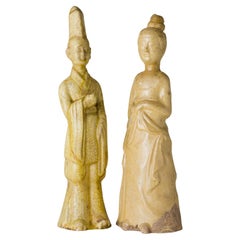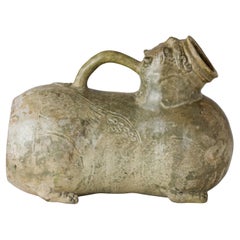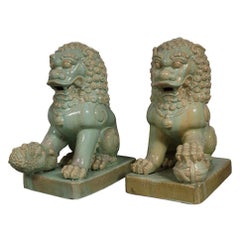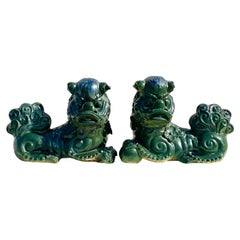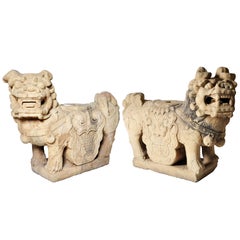Items Similar to Rare Yue Celadon-Glazed Two Haitai Statues, Western Jin dynasty (265-420)
Want more images or videos?
Request additional images or videos from the seller
1 of 6
Rare Yue Celadon-Glazed Two Haitai Statues, Western Jin dynasty (265-420)
$8,970per set
$29,900per set70% Off
£6,858.04per set
£22,860.14per set70% Off
€7,899.08per set
€26,330.27per set70% Off
CA$12,569.72per set
CA$41,899.07per set70% Off
A$14,032.91per set
A$46,776.37per set70% Off
CHF 7,353.03per set
CHF 24,510.11per set70% Off
MX$171,776.60per set
MX$572,588.67per set70% Off
NOK 93,383.61per set
NOK 311,278.69per set70% Off
SEK 88,048.88per set
SEK 293,496.28per set70% Off
DKK 58,951.64per set
DKK 196,505.48per set70% Off
Shipping
Retrieving quote...The 1stDibs Promise:
Authenticity Guarantee,
Money-Back Guarantee,
24-Hour Cancellation
About the Item
The statue seems to be a mythical beast standing in a poised and alert stance, with its mouth open as if roaring or breathing fire. Its body is covered in detailed carvings that resemble scales and feathers, indicative of the high level of craftsmanship during the Jin Dynasty. The creature’s presence is both regal and intimidating, suggesting it might have been believed to possess protective properties.
Period : Western Jin Dynasty (266 - 316 AD)
Type : Haitai Statue
Medium : Yue celadon(Stoneware)
Provenance : The piece was acquired in Hong Kong in the year 1999.
Reference :
1) Christies Hongkong 6 OCT 2015 - The Pavilion Sale - Chinese Ceramics & Works of Art Lot 72
* Yue Celadon
Yue celadon, also known as Yue ware, is a type of Chinese pottery with a celadon glaze, originating from the eastern Han dynasty in the Zhejiang province. The name 'Yue' comes from the Yue kilns which were among the earliest to develop the celadon technique. Yue ware is known for its jade-like glaze, which can range in color from bluish-green to olive green.
Yue celadon was highly regarded during its time and was the first Chinese ware to be imported in large quantities to the Middle East and Africa, significantly influencing the development of ceramics in those regions. The production of Yue ware continued to evolve, and during the Tang dynasty, it became more refined with more complex shapes and decorations. By the time of the Song dynasty, it had greatly influenced other kiln traditions, leading to the development of the classic longquan celadon, which became one of China’s most famous ceramic products.
Yue celadon traditionally embodies elements of auspiciousness and good fortune in Chinese culture. The jade-like celadon glaze is often associated with longevity and health. Various motifs and shapes inscribed on the pottery frequently symbolize luck and prosperity. For example, lotus patterns may represent purity and immortality, while animal figures like the lion symbolizes power, courage, and strength. Lions are considered protectors that ward off evil spirits and bring forth good luck. Furthermore, Yue celadon wares were commonly used as tomb offerings in ancient China, believed to bring fortune and well-being to the deceased in the afterlife.
- Dimensions:Height: 3.55 in (9 cm)Diameter: 4.14 in (10.5 cm)
- Sold As:Set of 2
- Style:Chinese Export (Of the Period)
- Materials and Techniques:Celadon,Glazed
- Place of Origin:
- Period:
- Date of Manufacture:265-420
- Condition:Repaired: Left statue's Right leg had been repaired. Minor fading.
- Seller Location:seoul, KR
- Reference Number:1stDibs: LU9577237947682
About the Seller
4.8
Gold Seller
Premium sellers maintaining a 4.3+ rating and 24-hour response times
Established in 1999
1stDibs seller since 2023
38 sales on 1stDibs
Typical response time: <1 hour
- ShippingRetrieving quote...Shipping from: seoul, Korea South
- Return Policy
Authenticity Guarantee
In the unlikely event there’s an issue with an item’s authenticity, contact us within 1 year for a full refund. DetailsMoney-Back Guarantee
If your item is not as described, is damaged in transit, or does not arrive, contact us within 7 days for a full refund. Details24-Hour Cancellation
You have a 24-hour grace period in which to reconsider your purchase, with no questions asked.Vetted Professional Sellers
Our world-class sellers must adhere to strict standards for service and quality, maintaining the integrity of our listings.Price-Match Guarantee
If you find that a seller listed the same item for a lower price elsewhere, we’ll match it.Trusted Global Delivery
Our best-in-class carrier network provides specialized shipping options worldwide, including custom delivery.More From This Seller
View AllLongquan Celadon Figurine, Ming Dynasty (1368-1644)
Located in seoul, KR
This sculpture is a Longquan celadon from the Ming Dynasty, renowned for its rich and jade-like green glaze. The figurine is likely a representation of a Buddhist deity or a revered scholar, showcasing the calm aesthetic expressions and graceful contours prevalent during the era. The spectrum of celadon glaze ranges from a dense grey stoneware to a nearly white porcelain texture, with unglazed parts revealing a terracotta brown upon firing. Such pieces were often part of household altars, reflecting the era's spiritual devotion. This artifact would be a treasured exhibit in any museum's Asian art collection, symbolizing both religious reverence and artistic excellence.
Period: Ming Dynasty (1368-1644)
Region: Longquan, China
Medium: Stoneware - Celadon glazed, with a range from heavy grey to almost white porcelain-like material
Type: Sculpture
Height : 24.5 cm
Provenance : Acquired in 1999, Hongkong
* Ming Dynasty Longquan Celadon
Longquan celadon from the Ming Dynasty typically exhibits a more robust and heavier stoneware body compared to its Song Dynasty predecessors. The Ming era saw an evolution in celadon glaze, achieving a wider spectrum of green hues, from olive to bluish-greens. Ming celadons...
Category
Antique 15th Century and Earlier Hong Kong Ming Antiquities
Materials
Celadon
$3,835 Sale Price
35% Off
Haitai Figurine from Ca Mau Ship circa 1725, Qing Dynasty, Yongzheng Era
Located in seoul, KR
The green-glazed beasts seated on their haunches, a short spout beside their turned heads, their mane and tail splashed with yellow or brown glaze
Period : Qing Dynasty, Yongzheng P...
Category
Antique 1720s Vietnamese Chinoiserie Antiquities
Materials
Pottery
Two Straw-Glazed Pottery Figures of Court Male and Female, Sui-Tang dynasty
Located in seoul, KR
This pair of straw-glazed pottery figures represents a male and female court attendant, both elegantly attired in period fashion. The female figure wears a flowing robe with draped f...
Category
Antique 15th Century and Earlier Hong Kong Tang Antiquities
Materials
Pottery, Straw
$1,400 Sale Price / set
30% Off
A Rare Yue Celadon-Glazed Figural Vessel, Western Jin dynasty (265-420)
Located in seoul, KR
This vessel is well-modeled as a recumbent winged lion with detailed decorative elements. It features a grimacing face with large protruberant eyes under heavy brows and a gaping mouth, which forms a large aperture. The piece has a tail that arches to form a loop handle, and the wings are incised on the sides. The whole piece is finished with a thin olive-green glaze.
This kind of figural vessel dates back to at least the Western Han dynasty, with the design fully developed in the Yue kilns of Zhejiang province during the 3rd and 4th centuries. Such zoomorphic forms became popular among the literati and were transformed into various functional objects like wine ewers and water pots.
There is a pair, and you can check it in the uploaded list. If you would like to purchase two in pairs, please leave a message.
Period : Western Jin Dynasty (266 - 316 AD)
Type : Figural vessel
Medium : Yue celadon(Stoneware)
Provenance : The piece was acquired in Hong Kong in late 1990s.
Reference :
1) Sotheby's New York 17 March 2015 - Chinese Art Through The Eye Of Sakamoto Gorō – Ceramics Lot 33
(Price Range : 15,000 USD-20,000 USD / Type : Highly related)
2) Sotheby's London 17 May 2023 - A Journey Through China's History. The Dr Wou Kiuan Collection Online. Part I - Lot 30
(Price realised : 13,970 GBP / Type : Closely related)
3) Ethnological Museum, Berlin, Germany - Pouring vessel in animal shape, China, Yue kilns, Zhejiang province, late Western or early Eastern Jin dynasty, 4th century
4) Sotheby's London 16 May 2018 - Important Chinese Art Lot 68
(Price realised : 50,000 GBP / Type : Closely related)
5) The MET - Accession Number: 1985.207 - Vessel in the Shape of a Tiger (Huzi)
(Type : Closely related)
* Yue Celadon
Yue celadon, also known as Yue ware, is a type of Chinese pottery with a celadon glaze, originating from the eastern Han dynasty in the Zhejiang province. The name 'Yue' comes from the Yue kilns which were among the earliest to develop the celadon technique. Yue ware is known for its jade-like glaze, which can range in color from bluish-green to olive green.
Yue celadon was highly regarded during its time and was the first Chinese ware...
Category
Antique 15th Century and Earlier Hong Kong Chinese Export Antiquities
Materials
Celadon
$9,950 Sale Price
50% Off
Two Green glazed Figures Holding Pitchpork, Han dynasty
Located in seoul, KR
Han dynasty pottery tomb figure, modelled standing holding a Pitchpork in front of his body, covered in a turquoise-green glaze. These two pieces are believed to have been produced i...
Category
Antique 15th Century and Earlier Hong Kong Han Antiquities
Materials
Pottery
$2,227 Sale Price / set
25% Off
Two Glazed Court Attendants, Ming Period (1368-1644)
Located in seoul, KR
Two finely hollow-moulded terracotta statuettes from ancient China, dating to the Ming Dynasty. The figure is depicted standing, dressed in long, flowing robes, painted in vibrant blue or green and deep amber yellow. The hair is styled into an elaborate top-knot, painted in a muted brown. Areas left unpainted would have been 'cold-painted' after firing, contrasting with the vivid fired blue or green and amber pigments. The figure is shown with the left hand raised to the chest, as if holding something, possibly an offering or incense. Figurines like this were placed in tombs to guide the deceased on their journey to the afterlife.
The Ming Dynasty was known for its exceptional artistic achievements, partly due to its economic prosperity. Since the Han Dynasty, it was customary to bury terracotta miniatures of everyday objects with the deceased. These items, known as mingqi, or "spirit utensils" and "vessels for ghosts," were believed to help and assist the deceased in the afterlife. Mingqi were crafted in the form of cooking utensils, miniature replicas of houses, temples, furniture, and other items. Anthropomorphic and zoomorphic terracotta figures were also popular, designed to assist, entertain, and recreate the living world for the deceased.
Period: Ming Dynasty
Medium: Green/blue-glazed Pottery
Type: Figure
Provenance : Acquired in late 1990s from Hongkong
Reference :
1) Ancient & Oriental - Terracotta Tomb Attendants
(Type : Highly related)
2) La Maison De La Petite Sara S.r.l. - Archaeology section - A Black glazed Terracotta Statuette, Servant with Trumpet, Ming Dynasty
(Price realised : 700 GBP / Type : Highly related)
* Ming Dynasty Glazed Pottery Figures
Ming Dynasty glazed pottery figures are renowned for their bold color palette, intricate detailing, and lifelike forms, distinguishing them from earlier traditions. These figures, which depict officials, warriors, animals, and mythical creatures, are characterized by high-gloss lead-based glazes in green, amber, ochre, and sancai (three-color) combinations. The thickly applied glaze pools in recesses, creating depth and enhancing sculptural details. With dynamic postures, expressive facial features, and meticulously rendered drapery, these figures reflect the period’s advancement in ceramic craftsmanship, offering a greater sense of movement and realism compared to the rigid and stylized forms of earlier dynasties.
A defining characteristic of Ming glazed pottery is its elaborate surface detailing, often achieved through raised relief elements and contrasting glazes. Equestrian figures, for example, feature carefully sculpted saddles, harnesses, and decorative embellishments, while human figures are adorned with intricate robes and headdresses. The large scale of these tomb figures, often more imposing than those from previous periods, underscores the increasing importance of funerary art during the Ming era. Unlike later Qing Dynasty figures...
Category
Antique 15th Century and Earlier Hong Kong Ming Antiquities
Materials
Pottery
$1,943 Sale Price / set
35% Off
You May Also Like
20th Century Antique Chinese Qing Era Porcelain Foo Dogs
Located in Pomona, CA
This pair of magnificent Chinese antique Porcelain lions/foo dogs statuary are hand made and hand carved porcelain. According to historical ...
Category
Early 20th Century Chinese Chinese Export Ceramics
Materials
Porcelain
Vintage Asian Glazed Ceramic Foo Dogs - a Pair
Located in West Palm Beach, FL
Stunning pair of glazed ceramic foo dogs. A chic deep green color with flashes of deep blue. Lots of intricate detail on the face and body. Areas of wear from age add to the effect. ...
Category
Late 20th Century Chinese Chinese Export Animal Sculptures
Materials
Ceramic
$1,950 / set
Pair of Chinese Stone Guardian Lions
Located in Chicago, IL
Often referred to as “Fu Dogs” in western culture, these handsome stone sentinels are iconic gatekeepers seen throughout China and elsewhere in Asia. Traditional symbols of protectio...
Category
Antique 19th Century Chinese Sculptures and Carvings
Materials
Limestone
$16,900 Sale Price / set
35% Off
Vintage Asian Glazed Terracotta Foo Dogs - A Pair
Located in West Palm Beach, FL
Infuse your space with cultural heritage and artistic elegance with this stunning pair of vintage Asian glazed terracotta Foo Dogs. Beautifully handcrafted and finished in a striking...
Category
Mid-20th Century Chinese Chinoiserie Figurative Sculptures
Materials
Terracotta, Paint
Pair of Mid 20th Century Glazed Terracotta Foo Dogs
Located in Stamford, CT
Pair of mid 20th century glazed terracotta foo dogs with a great colors. This is a good looking pair of Foo Dogs and a nice size for any room. Foo ...
Category
Mid-20th Century Chinese More Asian Art, Objects and Furniture
Materials
Terracotta
$3,400 Sale Price / set
20% Off
Large Pair of Antique Chinese Porcelain Foo Dogs
Located in Houston, TX
Large pair of antique Chinese porcelain foo dogs.
Stunning pair of antique Chinese hand decorated porcelain foo dogs or foo lions. T...
Category
Vintage 1920s Chinese Chinese Export Ceramics
Materials
Porcelain
$6,850 / set
More Ways To Browse
Rare Glazed
Statue Rare
Celadon Glazed
Antique China Ware
Large Celadon
Chinese Ceramics Song Dynasty
Asian Feather Art
African Statues
Large Jade Carving
Chinese Green Glazed Animal
Celadon Jade
Chinese Export Jade
Antique African Carvings
Jade Lotus
Asian Green Statues
Lion Ceramic Large
Ancient Chinese Jade
Song Dynasty Celadon
